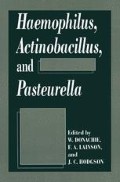Abstract
It is now 115 years since the work of Louis Pasteur on fowl cholera heralded the dawning of a new era in the control of bacterial diseases by vaccination. The causative organism was later identified as Pasteurella multocida which can be considered as the elder statesman of the group of bacteria we now refer to as HAP. In view of the prominent role of a member of this group in those pioneering days it would be reasonable to assume that todays vaccines reflect the sum total of 115 years of continued research and development. Pasteur’s studies on fowl cholera involved the evaluation of the virulence of P. multocida isolates in infected birds (Pasteur, 1880). Serendipity probably played a key role in this discovery of the concept of attenuation whereby strains maintained in his laboratory not only lost the ability to produce disease but also induced protective immunity against subsequent infection with a virulent strain. Nevertheless, Pasteur realised the implications of these results and went on to apply this approach to other diseases, notably anthrax and rabies. Soon afterwards, it was shown that inactivated vaccines could also induce protective immunity. On the face of it, we have made very little progress in vaccine technology since Pasteurs day as evidenced by the type of vaccines currently available i.e. live vaccines attenuated by non specific procedures and killed bacterins. Moreover, P. multocida continues to be a significant problem for poultry producers and in addition is implicated in other diseases particularly of cattle and pigs. Similarly, the vaccines on the market for other members of the HAP group seemingly owe more to Pasteurs research than subsequent work. One of the contributing factors to this state of affairs is the emphasis that has been placed on antimicrobial therapy as a means of controlling disease rather than prophylactic immunisation, although increasing concerns over antibiotic resistance and residues may be factors in the renewed interest in vaccine development.
Access this chapter
Tax calculation will be finalised at checkout
Purchases are for personal use only
Preview
Unable to display preview. Download preview PDF.
References
Adams, W.G., Deaver, K.A., Cochi, S.L., Plikaytis, B.D., Zell, E.R., Broome, C.V., and Wenger, J.D., 1993, Decline of childhood Haemophilus influenzae type b (Hib) disease in the Hib vaccine era, JAMA. 269: 221–226.
Conlon. J.A., Shewen, P.E., and Lo RYC., 1991. Efficacy of recombinant leukotoxin in protection against pneumonic challenge with live Pasteurella haemolytica, Inf Imm. 59: 587–591.
Donachie, W., and Gilmour, N.J.L., 1988, Sheep antibody response to cell wall antigens expressed in vivo by Pasteurella haemolytica serotype A2. FEMS Microbiol. Letters. 56: 271–276.
Donachie, W., Burrells, C. Sutherland. A.D., Gilmour. J.S., and Gilmour, N.J.L, 1986. Immunity of specific pathogen free lambs to challenge with an aerosol of Pasteurella haemolytica (biotype A, serotype 2): Pulmonary antibody and cell responses to primary and secondary infections, Vet. Imm. and Immunopath. 11:265–279.
Donachie, W., Sutherland, A.D., and Jones, G.E., 1986b, Assessment of immunity to Pasteurella haemolytica in sheep by in vitro methods. Developments in Biological Standards. 64: 63–69.
Espeseth, D.A., and Greenberg, J.B., 1993, Licensing and regulation in the USA, in “Vaccines for Veterinary Applications”, A.R.Peters, ed. Butterworth-Heinemann, Oxford.
Houghton. S.B., and Gourlay, R.N., 1983. Synergism between Mycoplasma bovis and Pasteurella haemolytica in calf pneumonia. Vet. Rec. 113: 41–42.
Gilmour, N.J., Martin, W.B., Sharp, J.M., Thompson, D.A., Wells, P.W., and Donachie, W., 1983, Experimental immunisation of lambs against pneumonic pasteurellosis. Res. Vet. Sci. 35: 80–86.
Jericho, K.W.F., and Langford, E.V., 1978. Pneumonia in calves produced with aerosols of bovine herpes virus 1 and Pasteurella haemolytica, Can. J Carp. Med. 42: 269: 277.
Jericho. K.W.F., Darcel. C.Q., and Langford, E.V., 1982. Respiratory disease in calves produced with aerosols of parainfluenza 3 virus and Pasteurella haemolytica, Can. J. Comp. Med. 46: 293–301.
Jones, D.M., 1993, Current and future trends in immunisation against meningitis, J.Antimicrob. Chemotherapy. 31: suppl.B 93–99.
Kroll, J.S., 1995. Genetics of pathogenicity of Haemophilus influenzae, HAP Conference, Edinburgh 1994.
Lee, A. 1993, Registration and regulation in the EC, in: “Vaccines for Veterinary Applications”, A.R.Peters, ed., Butterworth-Heinemann. Oxford.
Note for Guidance. 1994, Good clinical practice for the conduct of clinical trials for veterinary medicinal products. Committee for veterinary medicinal products working party on efficacy. European Commission Directorate General 111 Industry.
Pasteur. L., 1880, De L’atténuation du virus du choléra des poules, CR Acad. Sci. 91: 673.
Phillips, M. 1994. Animal Health and Nutrition Service, Wood Mackenzie Consultants Ltd, Edinburgh. USA Code of Federal Regulations 1989 pub Office of the Federal Register, National Archives and Records Administration. Washington.
Rossi-Campos. A., Campos, M., Potter, A.A., Harland, R., Bielefcldt-Ohmann, H., and Babiuk, L.A., 1992, Actinobacillus pleuropneumoniae: Modulation of pathogenesis by recombinant interferons. Proc. Int. Pig Vet. Soc. 1: 206.
van den Bosch, J.F., Pubben, A.N.B., Jongenelen, I.M.C. and Segers, R.P.A.M., 1995, An Actinobacillus phenopneumoniae subunit vaccine inducing protection in pigs against all serotypes, HAP Conference, Edinburgh 1994.
Author information
Authors and Affiliations
Editor information
Editors and Affiliations
Rights and permissions
Copyright information
© 1995 Springer Science+Business Media New York
About this chapter
Cite this chapter
Houghton, S.B. (1995). Commercial Development of Haemophilus, Actinobacillus and Pasteurella Vaccines. In: Donachie, W., Lainson, F.A., Hodgson, J.C. (eds) Haemophilus, Actinobacillus, and Pasteurella. Springer, Boston, MA. https://doi.org/10.1007/978-1-4899-0978-7_15
Download citation
DOI: https://doi.org/10.1007/978-1-4899-0978-7_15
Publisher Name: Springer, Boston, MA
Print ISBN: 978-1-4899-0980-0
Online ISBN: 978-1-4899-0978-7
eBook Packages: Springer Book Archive

